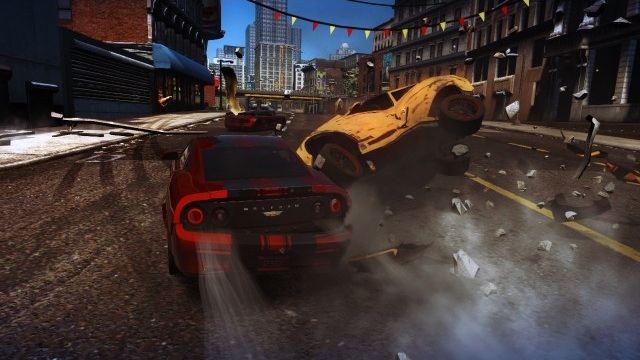A healthy disrespect for other people's property.
“This game is about destroying things,” Namco Associate Producer Ryan Azda tells me. Zipping through the streets of Shatter Bay, my chrome-plated car drifts under an overpass, barrelling through a concrete pillar before boosting to smash through the front of City Hall in a destructive shortcut, allowing me to move from sixth place to third. Another boost aimed at the third-place car reduces it to a pile of scrap rotating in slow motion. If everything I destroyed were made of gasoline instead of building materials, my experience with Ridge Racer Unbounded would have been a Michael Bay movie.
The game is a hefty departure from previous games in the series, which have been released with system launches (Ridge Racer Vita, for instance, provides a more traditional Ridge Racer experience). The shift in gameplay is Finnish developer Bugbear Studios' attempt to marry Ridge Racer’s arcade-style racing with car-crunching destruction. This isn’t Bugbear’s first go-round with vehicular destruction, with Flatout 1 and 2 in their rear-view mirrors.
Unbounded’s gameplay is centered around its boost feature. The boost gauge is filled by drifting, executing boosts that smash through shortcuts, or destroying other cars by boosting into them. Each of these methods also advances you in the race standings and increases the number of points you receive at the end of the race. Leveling up earns you better cars, and new races or challenges. In the challenges you have a limited amount of time which can be extended by meeting the level goals, like smashing into police cars with a semi-truck or executing extended drifts.
We had access to one of the game’s multiple cities, Shatter Bay. When I remarked that it reminded me of San Francisco, in which I was in a hotel playing the demo, I was told that the environments in the game were patched together from multiple cities, so they would feel recognizable to anyone. Additionally, we were told that the game allows players to create their own maps using a tile-based editor. As players level up, from playing through either the single player campaign or multiplayer, they acquire different tile-sets, allowing greater customization of their courses. These cities can be shared online.

Unbounded’s theme of destruction carries through not just in its boost mechanic, but also to almost every aspect of interacting with the environment. Getting bumped by a competitor might send you smashing through a waist-high brick wall, lamp post, or concrete pillar, with them crumbling or exploding but not affecting the handling or speed of the car. Smash into an unbreakable wall and it’s your car that crumples into wrecked pieces of slag.
Bashing your car into the competition and turning them into spinning metal coffins, zipping past on a quick boost, or catching an inside-line is all good traditional racing-game fun, but it’s the destructible shortcuts where Unbounded really comes into its own. Boosting just before striking the red target and smashing through a brick wall, zooming through the interior of a market or a condemned bridge at double speed is quite a rush. Finding yourself a few places ahead of where you started just feels like a minor added bonus by comparison.

Many of Unbounded’s features have been around for a while. I was reminded immediately of Burnout 3: Takedown with the game’s focus on crashing into other vehicles, and the destructible shortcuts reminded me a little bit of Motorstorm Apocalypse’s changing tracks. However, games have always built on or adapted successful ideas, and Ridge Racer Unbounded’s destructive arcade racing is pulling together a lot of diverse racing tropes that could be very successful when they're all pull together.











